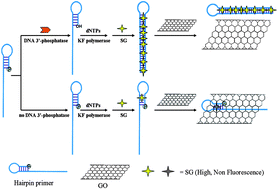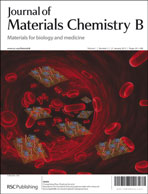We have developed a label-free, simple and highly sensitive hairpin fluorescent biosensor for the assay of DNA 3′-phosphatases and their inhibitors utilizing a graphene oxide (GO) platform. In this assay, we designed a hairpin primer (HP) with a 3′-phosphoryl end that served as the substrate for DNA 3′-phosphatases. Once the phosphorylated HP was hydrolyzed by DNA 3′-phosphatases, the resulting HP with a 3′-hydroxyl end was immediately elongated to form a long double-strand product by Klenow fragment polymerase (KF polymerase). With SYBR green I (SG) selective staining of the double-helix DNA, a very high fluorescence enhancement was achieved. Furthermore, GO was introduced to quench the fluorescence of the HP without polymerase elongation, thereby further increasing the signal-to-background ratio. The proposed method is simple and convenient, yet still exhibits high sensitivity and selectivity. This method has been successfully applied to detecting the activity of two typical 3′-phosphatases, T4 polynucleotide kinase phosphatase (PNKP) and shrimp alkaline phosphatase (SAP). The effect of their inhibitors has also been investigated. The results revealed that the method allowed a sensitive quantitative assay of T4 PNKP and SAP, with detection limits of 0.07 U mL−1 and 0.003 U mL−1, respectively. The proposed method is anticipated to find applications in the study of DNA damage repair mechanisms.

You have access to this article
 Please wait while we load your content...
Something went wrong. Try again?
Please wait while we load your content...
Something went wrong. Try again?


 Please wait while we load your content...
Please wait while we load your content...